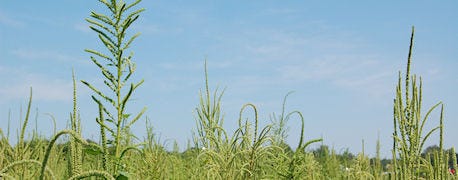
Unfortunately, weeds didn't get the memo about crop prices falling off a cliff.
As a result, farmers will need to spend a big chunk of money to control tough weeds like Palmer amaranth and waterhemp. Purdue University weed scientist Bryan Young advises growers spend their money wisely when trying to control these two fast-growing weeds. FYI: Young notes waterhemp will grow 1- to 1 ¼-inches per day, while Palmer amaranth will put on 1 ½- to 2-inches of growth per day.
Related: Palmer Amaranth: Understanding the Profit Siphon in your Field

Don't skimp on controlling tough weeds
These growth rates have the biggest impact on management, Young says. Three to four inches is the maximum controllable height for any herbicide on both weeds. Waterhemp emergence begins in late April. Palmer amaranth will start popping up in early-May. Both weeds are actively emerging and growing through the first frost in November.
Considering the amount of seed these weeds are capable of generating, Young recommends season-long management. It takes just three weeks for Palmer amaranth to go from emergence to flowering.
For growers who have sporadic misses on Palmer amaranth, Young advises walking the field and removing it by hand.
"Don't combine it, you'll spread it everywhere," he adds. "Palmer amaranth can get out of control in just a couple of years."
Also, he's not joking when he advises farmers to avoid used equipment from the south. While at Southern Illinois University – Carbondale, he watched a Palmer amaranth problem spiral out of control. The farmer was able to trace it back to the source – a used combine from the Missouri Bootheel.
~~~PAGE_BREAK_HERE~~~
Pay attention to groups
Numerous universities are pushing farmers to pay attention to a new chart that groups herbicides by mode of action.
Financial support for the project was provided by the United Soybean Board and others. To view the chart, Google "Purdue herbicide classificiation."
Related: Tips for controlling resistant weeds in Indiana
Using the grouping chart, growers are able to build an herbicide program that utilizes multiple modes of action. Though, as Palmer amaranth continues to build resistance, only a few groups are viable these days. Young recommends Group 14 (PPO inhibitors) and Group 15 (long-chain fatty acid inhibitor) for pre-emergence control of Palmer amaranth and waterhemp. Moving into the growing season, he advises growers consider another application of a Group 15 herbicide to extend the residual control of these weeds.
University of Arkansas retired weed scientist Ford Baldwin agrees Group 14 herbicides provide post-emergence (foliar) control of Palmer amaranth. However, he also recommends Group 10 (glufosinate/Liberty) for post-emergence control.
Furthermore, as more and more growers continue to rely on PPO inhibitors for control of these tough weeds, Baldwin worries they'll soon be as ineffective as glyphosate (Group 9, by the way). He points to University of Illinois' Aaron Hager's resistance testing program as proof of Group 14's future. Baldwin notes approximately two-thirds of the samples sent in tested positive for PPO resistance. Granted, these were all samples that were already suspected of being herbicide resistant.
"We're driving the Group 14 herbicides off a cliff," Baldwin notes.
~~~PAGE_BREAK_HERE~~~
New/old technology
What about Monsanto's new Roundup Ready Xtend crop system and Dow's Enlist crop system? Both rely on Group 4 herbicides – dicamba for Roundup Ready Xtend and 2,4-D for Enlist. Baldwin advocates for hybrids and varieties that stack both technologies together to further extend the usefulness.
Understanding the Profit Siphon in your Field
It's a giant amongst weeds. For that matter, it's a giant amongst men. And wherever it goes, if it gets a head start, it will leave you hoping Superman will show up and wipe it out. Download our free report: Palmar Amaranth: Understanding the profit siphon in your field
"My concern is we could ruin these new traits before we get a chance to stack them together," Baldwin notes.
Lastly, Young says many growers have inquired about controlling these superweeds with tillage. He says this method can work, but it's not just a till it and forget it situation. With tillage, growers are attempting to bury the weed seed deep to reduce the overall seed bank in the upper germination zone of the soil where these small-seeded weeds originate. This practice will have the greatest impact on those that have major weed failures the year before and deep bury the seed with a moldboard plow.
Then, tillage should be limited in the field for the next five years as any sort of disturbance may bring those resistant weed seeds back to the top. Even a knife application of anhydrous ammonia can be enough to bring weed seed to the surface.
About the Author(s)
You May Also Like




